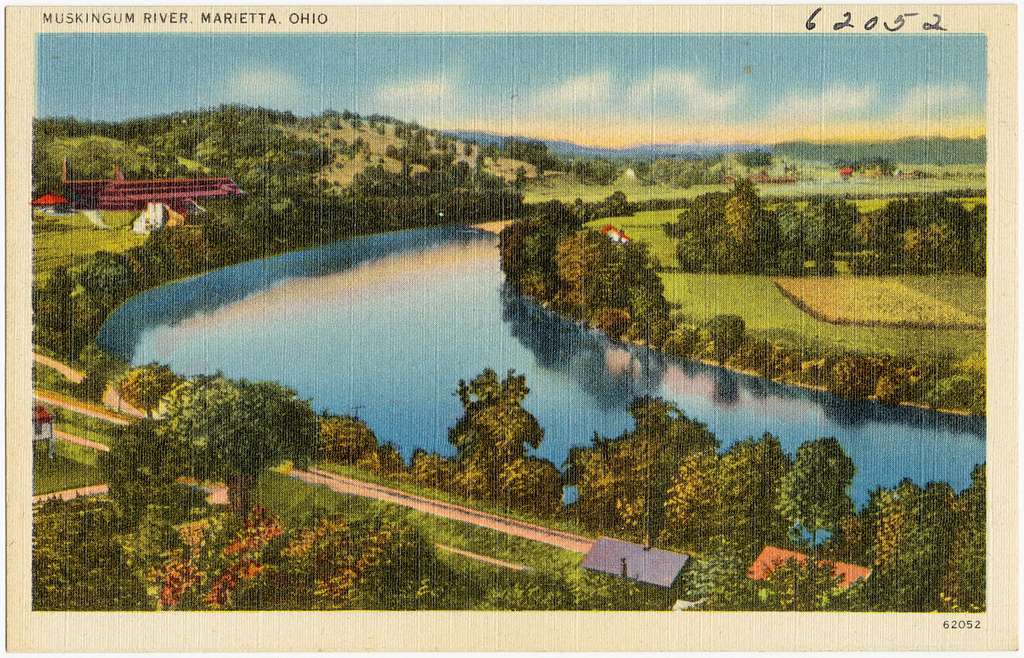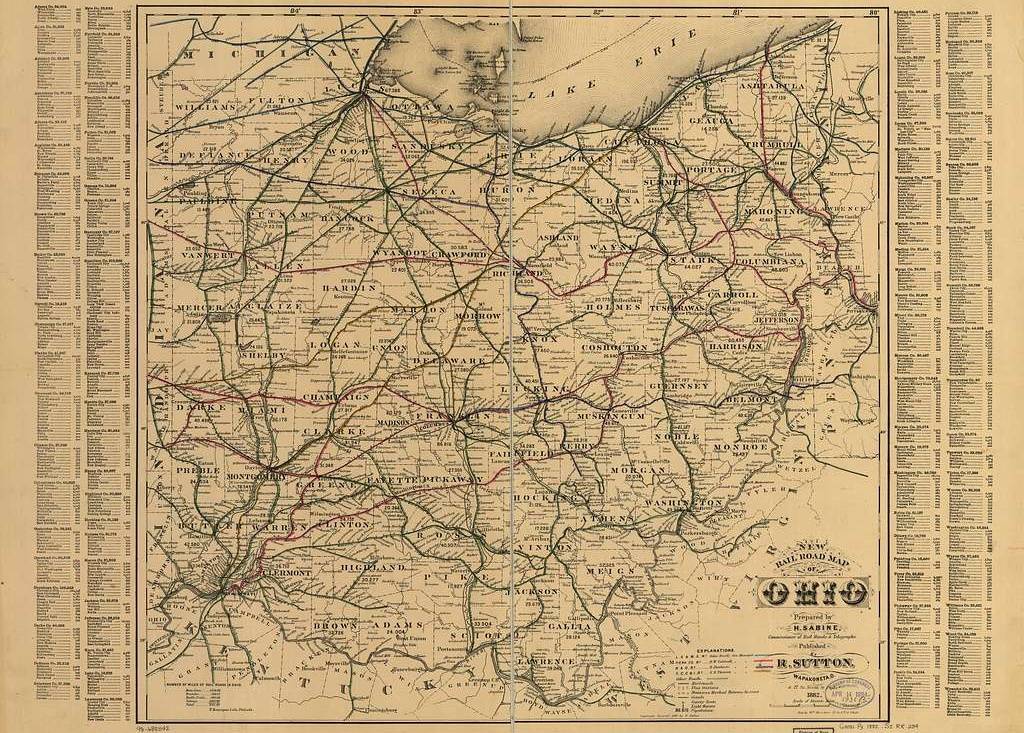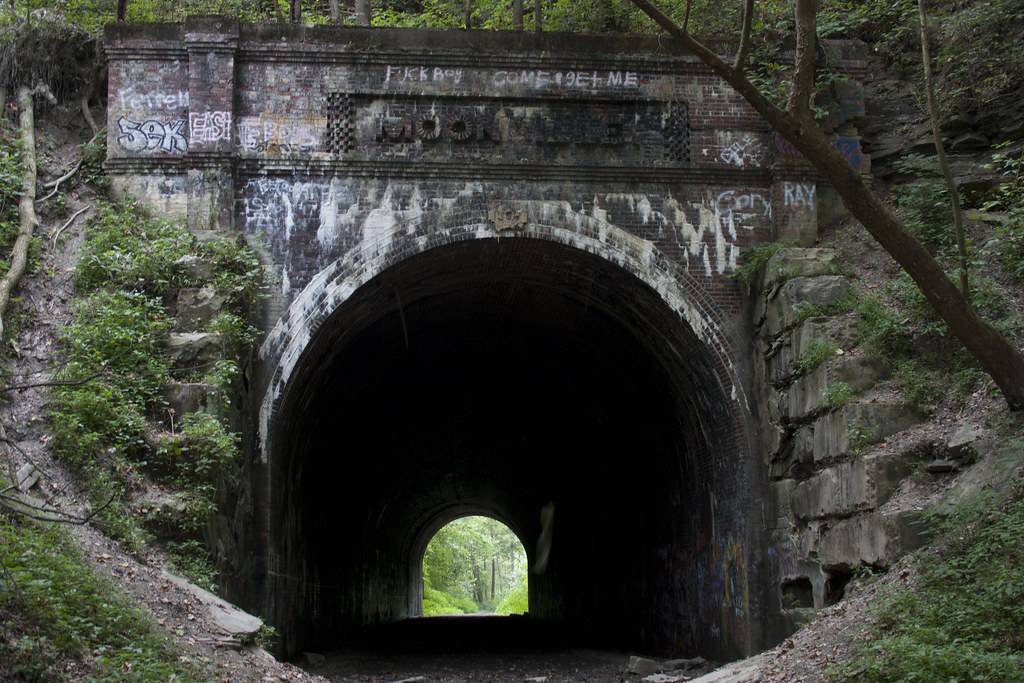When looking at the history of Ohio, sometimes we’re tempted to start sometime around 1803 when Ohio officially became a state. There are a few problems with this, though, such as how it completely ignores the period of time from 1787 to 1803 when the area was part of The Northwest Territory. Starting then is likewise problematic as it fails to encompass important events during The American Revolution, The French and Indian War, or even going back to 1640 for the Beaver Wars.
That is one of the big problems with history, generally speaking. Every event that ever happened somehow relates to events that happened before it. And these events point to even earlier events, and the cycle continues.
Even if we went all the way back to the Paleoindian Period, which historians seem to think occurred between 13000 to 8000 B.C., when indigenous humans first set foot on the region’s soil, geologists can go back in time even further, like a billion years ago, something about the metamorphic crystalline basement rock doing the Hokey-Pokey and turning itself around, or something like that. Honestly, even the geologists aren’t quite sure what was happening way back then.
Because we have to start somewhere, I’m going to suggest that it all began, more or less, in the mid-1600s.
The Seventeenth and Eighteenth Centuries
European settlers first started to set foot in what would later be called The United States of America at the dawn of the seventeenth century. The first colony, Jamestown, was established in 1607 and in the years that followed, more and more settlements were formed at various points along the Atlantic coast. There were some indigenous tribes living close to the coast, and for the most part, everyone seemed to get along. (Keyword: “seemed”)
It’s relatively important to note that each of the native tribes existed in and of themselves. Sometimes, the various tribes would make alliances with each other, such as what we refer to as The Iroquois Confideracy, which was made up of tribes of the Mohawk, Oneida, Onondaga, Cayuga, Seneca, and later on the Tuscarora after 1722.
The natives helped the Europeans by teaching them about new-world plants, like corn and tobacco but before long it was another commodity that became the next big thing: animal skins. The settlers just loved the skins (or furs) of Raccoons, Foxes, Minks, Deer, and owning items (not just clothing) made from these items became something of a status symbol. At the top of the most-wanted list was beaver. Only the elite or most successful people could afford beaver pelts.
These settlers also had something the native tribes wanted badly as well: metal, as in, tools made of metal, which were a lot more effective and lasted a lot longer than the more primitive tools the natives had. Later on, firearms also came into play.
It didn’t take very long for the beaver population in The Iroquois region (mostly upstate new york, but extending past today’s boundaries) to become depleted. By this time, the European (mainly the Dutch and British) settlers wanted more beaver skins, and they had a growing number of metal tools (and firearms) to provide in trade, and therein lies the problem.
The Iroquois nations expanded their beaver hunting area, going as far north as Canada and westward through Ohio and eventually all the way to The Mississippi River. Unfortunately, the tribes that already existed in those regions didn’t seem to like Iroquois tribes coming onto their lands, and I think maybe they were a bit fearful that with all the goods they had been getting from the settlers, they were becoming more powerful and that could be a problem.
Thus began what we now refer to as The Beaver Wars.
By 1656, The Iroquois Confederacy had gained control over what is now Ohio. Native tribes are fighting among each other. The Dutch and British and French are joining in, trying to get their hands on such valuable loot.
This war officially came to an end in 1701 with the signing of the Treaty of Peace (or Grande Paix) between the Iroquois, The French, and the British. The Iroquois promised to stop trying to fight the tribes of the Ohio valley and allow them to return to their homelands, and everyone else just wanted to get along. History tells us this was massively successful, he said sarcastically pointing to The French and Indian War that started a few years later. Okay, there was also the fact that the native tribes, the French, British, and Dutch settlers kept fighting over land rights for years to come. But, at least The Beaver War was over.
In 1745, in the Virginia Colony, The Ohio Company was formed by a number of wealthy families, including a few related to George Washington. In an attempt to help the British gain control over the lands west of the Appalachian Mountains, they would purchase blocks of land from the King and then sell the land to British folk wanting to move west (for a pretty decent profit, I might add.) The king let them have (ok, buy) 200,000 acres of land near the headwaters of the Ohio River (which today is in Pennsylvania) and distribute (ok, sell) that land to 100 families. And, they had to construct a fort to make sure all those settlers were safe.
Enter a dude named Christopher Gist. He’s charged with the small task of surveying the lands of what today is southern Ohio and Northern Kentucky. He was able to come up with one of the earliest and best surveys of this region. He helped establish trade between the local tribes and the British. Anyway, based in no small part on his work, The Ohio Company decided to settle south and east of The Ohio River, what today is part of Pennsylvania and West Virginia.
This didn’t go over very well with the French, who were also claiming that land belonged to them. The French built a couple of forts of their own, Fort Le Boeuf (today Waterford, Pennsylvania) and Fort Machault (today, Franklyn, Pennsylvania).
The Lieutenant Governor of the Virginia Colony, Robert Dinwiddie, didn’t like the French building forts on land that was supposed to be under his purview, so he convinced George Washington and Christopher Gist to head off to Fort Le Boeuf and try to settle things. The French were not impressed, so Washington and Gist left empty-handed, with the French promising to arrest any British settlers they found on this land, and the British promised to forever fart in the general direction of the nearest Frenchman. (Sorry for the bad Monty Python joke.)
The French took it a step further when they built yet another fort, Fort Duquesne (today Pittsburg, Pennsylvania) in a region the British were active in. Once again, George Washington and Christopher Gist tried to reason with the French, and when that went nowhere, Washington built his own fort, Fort Necessity (today a short way south of Pittsburg).
And the French declared war. Literally. The French and Indian War – which lasted from 1756 to 1763.
The native tribes allied themselves with the French for a few reasons. First off, the British were wanting the lands west of The Appellations to live on and expand their reach, lands the indigenous people thought were theirs in the first place since they were there first. The French, on the other hand, just wanted to trade with the tribes and felt that wasn’t going to be possible with the British taking over.
In the end, the British won the war, The Treaty of Paris (1763) was signed, and the members of The Ohio Company had lost all their investments because they legally couldn’t sell any of the lands they were fighting for.
The Road to Statehood
The Ohio Country is what people called the region north of the Ohio River, west of the Appalachian Mountains before The American Revolution. As such, it didn’t have clearly defined boundaries, but everyone seemed to know where it was. Another issue is that both France and Great Brittian wanted the land, and were prepared to violently fight for it. However, after the French and Indian War concluded, the French seceded to the British, but that wouldn’t last long.
The American Revolution, of course, changed everything. With the signing of The Treaty of Paris in 1783, Britain recognized American Independence. This also meant that they were giving up any claims they had on land in Ohio Country.
However, there were still a few issues. First off, you still had native tribes living in the region who didn’t particularly agree that their lands now belonged to America. Secondly, several states said that at least part of these lands belonged to them. Third, the new American government feared that there were people hiding out in Ohio Country, essentially squatting or hiding from something, and some people in Congress feared these people might try to form their own nation as this area was separated from the colonies by a rather large mountain range.
Congress began to negotiate with the states and native tribal leaders, essentially trying to get them to agree that the federal government had sole control over the lands.
Meanwhile, Congress also enacted the Land Ordinance of 1784, which called for all the lands between the Appalachian Mountains and the Mississippi River, and north of The Ohio River to be divided up into ten distinct states. The problem was that this ordinance didn’t say anything about how the land would be divided up, or how it would be settled. They tried again with the Land Ordinance of 1785.
This ordinance created square townships, six miles long, or thirty-six square miles. The township would then be divided into one square mile sections (or, 640 acres). Each of these sections would receive a number, which would indicate how the land would be used. For example Section 16 would be for schools. Sections eight, eleven, twenty-six and twenty-nine were to be reserved for veterans who fought in wars to build upon and settle. The rest would be sold for a dollar an acre at a public auction.
The first area in Ohio became known as The Seven Ranges – an area near the Ohio Country boundary to Pennsylvania – surveyors plotted eight lines, six miles apart, ready for settlement.
In the end, the Land Ordinances of 1784 and 1785 didn’t actually solve all that many problems: The area’s native tribes still refused to leave … and there was still a squatting problem.
In 1786, the Ohio Company of Associates was formed in Massachusetts, which sounds an awful lot like The Ohio Company, but there was absolutely no affiliation whatsoever. They wanted to purchase The Seven Ranges and sell it off to settlers. If only it were that easy. They had to negotiate many deals with the federal government, and before long they were finally granted the land. They set up shop in a new settlement along the Ohio River, in 1788 a town that would become known as Marietta.
The year before that, The Northwest Ordinance established the Northwest Territory, which would pave the road toward statehood. In 1800, the new city of Chillicothe was named the capital of the Northwest Territory.
Two years later, Congress passes The Enabling Act, which would set the stage for admitting Ohio to The Union. The Constitutional Convention met at Chillicothe and Ohio’s first constitution was drafted. After that, Thomas Worthington presents the Ohio Constitution to Congress for approval and the following year then president Thomas Jefferson signed legislation making Ohio the seventeenth state of The Union.

Except, there was one, teeny problem. Congress kind of forgot to vote on it. So, technically speaking, without the approval of Congress, Ohio couldn’t have become a state. But, it did. Or, at least, everybody seemed to think so.
1953 – Ohio Becomes A State
From 1803 to 1952, everyone thought Ohio was a state. Ohio called itself a state. The United States Government called it a state. Therefore, it’s a state, right? It wasn’t Ohio’s fault that Congress forgot to vote on it … and it wasn’t like there was anything malicious going on. Making states was a relatively new thing, and let’s face it there was a lot of Confusion over Ohio Country so in the long run it’s really hard to blame Congress for such a minor oversight.
In 1953, Congress finally corrected its mistake, took the required vote, and (retroactively) declared that Ohio joined The Union on March 1, 1803.
Yes, in 1953 Ohio officially became a state … starting date roughly 150 years ago.
Who said History wasn’t confusing?
Dig Deeper!
- History of Ohio – Wikipedia
- Ohio History Central and The Timeline of Ohio History
- The Story of Early Ohio: Indians, Frontiersmen, Pioneers, Statesmen and War by William Dean Howells and C. Stephen Badgley; ISBN – 0615988180
- History of Ohio: A Captivating Guide to the People and Events That Shaped the History of the Buckeye State by Captivating History; ISBN – 1637167350



